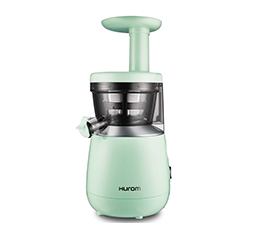And then I got my hands on a Hurom HZ Slow Juicer. Despite the upfront investment, could at-home juicing be the answer to my wallet-busting habit in the long run? And would the taste hold up?
Off the bat, I noticed that the Slow Juicer is distinctly different from the one I had in college (and gave away because it was the worst to clean). Instead of operating at a crazy volume (that my roomies hated), the HZ is exceptionally quiet―which is crucial when you live with, well, anyone.
Plus, the super chic rose gold appliance—compact enough for even my tiny New York City kitchen—is designed to actually upgrade the nutrient value of your juice. That's because of the blade-less, slow squeeze technology, which uses a gear to crush fruits and veggies and then presses them through a strainer. The process minimizes damage to your ingredients, meaning the enzymes and nutrients are intact by the time they make it to your glass. In short, it was a promising start.
Keep reading to find out how my week of at-home juicing went—and whether I plan on making the permanent switch to DIY juice maven.

1. Making juice whenever I wanted was a luxury—and saved me money
Waking up and sipping juice in my pajamas felt downright amazing—and spared me 20 extra minutes in bed I'd otherwise spend running to a café. For my first glass of DIY juice, I turned to an old favorite: carrots, kale, apples, beets, and lemon. I picked up and chopped veggies the night before, so when I woke up in the a.m. the whole process took about five minutes.
Since the Hurom Slow Juicer comes with its own drying rack (where all of the parts fit perfectly), cleanup is crazy easy—and means you'll never have to freak out over missing parts. Another major perk: Juicing for seven days put $50 (that I would have spent) back into my pocket.

2. I skipped buying store-bought almond milk, too
After attempting homemade almond milk months ago, I knew I didn't want to mess with a cheese cloth ever again. But considering how easy the Hurom is to clean, I thought I’d give it one more try.
Turns out, it was a game-changer. I soaked a bag of almonds overnight using a one-to-one ratio of cups of almonds and water, then ladled the mixture into the juicer the next day. In about two minutes, I had oh-so-smooth nut-based creamer for my coffee. The best part: My almond milk had no fillers, added flavors, or sugar like the store-bought stuff (and it added extra oomph to my golden milk, too).

3. I doubled my veggie intake—without messing with my gut
As a plant-based eater, I can reach the daily recommended amount of veggies and fruits by lunchtime—but too much fiber often messes with my gut. Since the HZ Slow Juicer extracts juice from produce, expelling the dry-to-the-touch pulp (AKA leaving the fiber behind), I could fill up on nourishing veggies and fruits at every meal without the digestive stress.
On the weekends, I like to give my tummy (and mouth) a much-needed break from five days of salads. For me, Saturdays and Sundays are made for enjoying all the things (like pasta, burgers, and fries), but I still got in all of the nutrients from pounds of produce without noshing on salad.

4. It's more sustainable than I thought
In my apartment, you’ll find stainless-steel straws, microfiber cloths, and dozens of totes―so thinking about tossing pulp from homemade juice was a major hurdle. But to my surprise, the HZ Slow Juicer actually helped me waste less in the kitchen.
I added veggie scraps destined for the trash into my juice, like too-mealy apples, tough kale stems, and romaine lettuce that sat in the fridge for a bit too long. I also used post-juice pulp in recipes, like celery pulp in veggie stock and almond pulp in meatless meatballs. And the rest? That went to my compost pile.
Overall, the experience made my juice obsession possible without breaking the bank. And since I had all that pulp to work with, I was cooking more often and eating out less. I believe they call that a life hack.
Shop Now
Good news: Hurom is offering 25 percent off for Mother's Day through 5/13/18! Just use code BESTMOMEVER at hurom.com
In partnership with Hurom
Top photo: Hurom
Loading More Posts...


